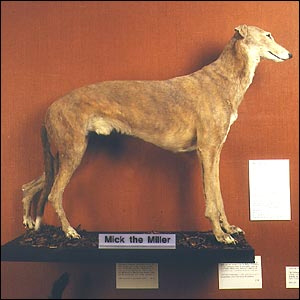(Afghan Hound Database and Breed Information Exchange)
(British Museum)  This is a straight copy and paste from the original authors website. Normally I would just link to the external site but I didn't want to lose this great article about Mick The Miller, heaven forbid should the reference site ever cease to exist, so on this rare occasion its a copy rather than a link Seeking to be fair and honest and give the original author full credit for their work I give below the URL to the original article - (betting.betfair.com) Still the most famous greyhound who ever raced, Darrell Williams tells the tale of this most remarkable racer. Mick The Miller is without doubt the most famous greyhound ever to have raced. The fact his career coincided with the sport's formative years probably helped, but quite simply what he achieved is highly unlikely ever to be repeated. Bred by a gambling mad priest, Father Martin Brophy, Mick was one of a litter of ten born in June 1926. Various stories about his early days have been told, often highlighting his weakness as a pup, but he was certainly diagnosed as suffering from distemper, most likely around May 1928, by which time he had already won four races for trainer Mick Horan having made a successful debut at the then new track of Shelbourne Park in Dublin a month earlier. Reportedly cared for by the track's veterinary surgeon Arthur Callanan, Mick did not return to the track until March 1929, although it is believed he did compete in local coursing meets during the previous winter. Successful in 11 of his 15 races in Dublin during the next three months, including three major prizes, it was then decided to continue his career in England, and in particular the Derby. His introduction to White City could not have been more remarkable. In a solo trial over 525 yards he broke the track record, before days later clocking a world record time of 29.82 in the first round of the 1929 Derby, becoming the first greyhound ever to break the 30 second barrier. Unsurprisingly numerous offers were made to buy Mick at this time, with Wimbledon bookmaker Albert Williams securing the successful bid, but on the understanding that Father Brophy would keep the prize money if he won the Derby. Win he did, but only in a re-run after the original race was declared void - something that wouldn't happen nowadays - when three of the runners, Mick included, were knocked over. Within weeks Mick had another new owner, Arundel Kempton, who paid 2000 guineas for him, a huge sum considering his Derby win had netted Brophy 800 pounds, and he joined trainer Sydney Orton. Mick's career went from strength to strength, winning the International at West Ham - he thrived on the big galloping tracks, where his trackcraft was best served - finishing a short-head second in the London Cup at White City, before claiming the Champion Stakes at Wimbledon on New Years Day 1930. He also won any number of 'match' races, one off 'winner takes all' contests against one other rival before winning the Spring Cup at Wembley in March 1930. His victory in the semi-final of that event would start a sequence of 19 consecutive victories, which would include a successful defence of his Derby crown as well as unbeaten runs in both the Welsh Derby and Cesarewitch, setting world record times twice in both events. Injured in the Laurels in August 1930, Mick was not to see the track again until March 1931, returning to again win the Spring Cup in track record time, before bidding for a third Derby in June 1931. At the age of five, time was perhaps beginning to catch up with Mick, as he was beaten in all three qualifying rounds, but still went off as favourite for the final. His incredible third victory however would amount to nothing, as once again the race was declared void and a re-run staged. The two races in one night were simply too much for Mick and he trailed in fourth. But Mick's story was still not fully told. Expected to be retired, he was stepped up to 700 yards for the St Leger in September 1931, the longest trip he had ever attempted. To his eternal credit, Mick achieved the remarkable feat of going unbeaten through the event, becoming the first dog to win the Derby and Leger, and the only ever to have also won the Cesarewitch. His career on the track was over, but Mick was still in demand, even starring in a film, Wild Boy in 1935, and making numerous guest appearances, sharing time with celebrities and even royalty. Mick passed away in May 1939, his body was embalmed and to this day he remains at the British Natural Museum in Tring. |